A Novel VSG Control Strategy for UPS Voltage Source Inverter with Impulsive Load
Abstract
:1. Introduction
2. System Topology Analysis and Design
3. The Proposed Control Strategy
3.1. VSG Control Strategy
3.1.1. VSG Topology
3.1.2. VSG Control Scheme
3.2. Dynamic Switching Method
4. The Simulation and Experimental Results
4.1. Simulation Parameters and Results
4.1.1. Simulation Parameters
4.1.2. Simulation Results
4.2. Experimental Results
5. Conclusions
Author Contributions
Funding
Data Availability Statement
Conflicts of Interest
References
- Wang, G.; Wang, P. Rotor loss analysis of PMSM in flywheel energy storage system as uninterruptable power supply. IEEE Trans. Appl. Supercond. 2016, 26, 1–5. [Google Scholar]
- Aamir, M.; Mekhilef, S. An online transformerless uninterruptible power supply (UPS) system with a smaller battery bank for low-power applications. IEEE Trans. Power Electron. 2017, 32, 233–247. [Google Scholar] [CrossRef]
- Guillardi Junior, H.; Amaral Serni, P.J. A review of project of the controllers for an UPS. IEEE Latin Am. Trans. 2018, 16, 314–321. [Google Scholar] [CrossRef]
- Wang, S.; Gao, K.; Ge, Y.; Shi, Y.; Zhao, J.; Ju, R.; Ji, H. Discussion on the relationship between UPS battery connection method and its reliability. In Proceedings of the 2018 9th International Conference on Intelligent Control and Information Processing (ICICIP), Wanzhou, China, 9–11 November 2018. [Google Scholar]
- Abaray, S.; Beaver, S.; Nguyen, C. How reliable is your ups? Eliminating single points of failure. In Proceedings of the 2017 Petroleum and Chemical Industry Technical Conference (PCIC), Calgary, AB, Canada, 18–20 September 2017. [Google Scholar]
- Wei, Y.; Xu, Y.; Zou, J.; Li, Y. Current limit strategy for BLDC motor drive with minimized DC-link capacitor. IEEE Trans. Ind. Appl. 2015, 51, 3907–3913. [Google Scholar] [CrossRef]
- Chen, B.; Hsu, C.; Lai, Y. Novel current limitation technique without current feedback for digital-controlled battery charger in UPS applications. In Proceedings of the 2010 IEEE Energy Conversion Congress and Exposition, Atlanta, GA, USA, 12–16 September 2010. [Google Scholar]
- Wei, B.; Marzàbal, A.; Perez, J.; Pinyol, R.; Guerrero, J.M.; Vásquez, J.C. Overload and short-circuit protection strategy for voltage source inverter-based UPS. IEEE Trans. Power Electron. 2019, 34, 11371–11382. [Google Scholar] [CrossRef]
- Zhu, F.; Peng, Z.; Hu, W.; Wang, H.; Zhang, C.; Zhao, Z.; Dai, Y. An improved VSG control strategy for microgrid. In Proceedings of the 2021 IEEE International Conference on Electrical Engineering and Mechatronics Technology (ICEEMT), Qingdao, China, 2–4 July 2021. [Google Scholar]
- Yang, Y.; Wang, X.; Wang, Z.; Dong, X.; Yang, W.; Gao, Y. Research on control strategy of virtual synchronous generator based on energy storage wind farm. In Proceedings of the 2021 IEEE 5th Advanced Information Technology, Electronic and Automation Control Conference (IAEAC), Chongqing, China, 12–14 March 2021. [Google Scholar]
- Shao, Y.; Yang, R.; Li, X.; Chen, G. Battery energy storage system with energy spring based on VSG control strategy. In Proceedings of the 2019 10th International Conference on Power Electronics and ECCE Asia (ICPE 2019-ECCE Asia), Busan, Korea, 27–30 May 2019. [Google Scholar]
- Liu, D.; Zhong, Q.; Wang, Y.; Liu, G. Modeling and control of a V2G charging station based on synchronverter technology. CSEE J. Power Energy Syst. 2018, 4, 326–338. [Google Scholar] [CrossRef]
- Jun, F.; Meng, J. Modeling and parameter design of marine micro-grid virtual synchronous generator. In Proceedings of the 2021 IEEE 4th Advanced Information Management, Communicates, Electronic and Automation Control Conference (IMCEC), Chongqing, China, 18–20 June 2021. [Google Scholar]
- Marin-Hurtado, A.J.; Escobar-Mejía, A.; Alzate-Gómez, A.; Gil-González, W. Adaptive virtual synchronous machine applied to four-leg three-phase VSC. In Proceedings of the 2021 IEEE Southern Power Electronics Conference (SPEC), Kigali, Rwanda, 6–9 December 2021. [Google Scholar]
- Younis, T.; Ismeil, M.; Orabi, M.; Sayed, M.A.; Takeshita, T. Single-phase virtual synchronous generator without a dedicated synchronization unit. In Proceedings of the 2015 IEEE International Telecommunications Energy Conference (INTELEC), Osaka, Japan, 18–22 October 2015. [Google Scholar]
- Mir, A.S.; Senroy, N. Self-tuning neural predictive control scheme for Ultra-battery to emulate a virtual synchronous machine in autonomous power systems. IEEE Trans. Neural Netw. Learn. Syst. 2020, 31, 136–147. [Google Scholar] [CrossRef] [PubMed]
- Wu, H.; Ruan, X.; Yang, D.; Chen, X.; Zhao, X.; Lv, Z.; Zhong, Q. Small-signal modeling and parameters design for virtual synchronous generators. IEEE Trans. Ind. Electron. 2016, 63, 4292–4303. [Google Scholar] [CrossRef]
- Li, X.; Hu, Y.; Shao, Y.; Chen, G. Mechanism analysis and suppression strategies of power oscillation for virtual synchronous generator. In Proceedings of the IECON 2017 43rd Annual Conference of the IEEE Industrial Electronics Society, Beijing, China, 29 October–1 November 2017. [Google Scholar]
- Meng, X.; Liu, J.; Liu, Z. A generalized droop control for grid-supporting inverter based on comparison between traditional droop control and virtual synchronous generator control. IEEE Trans. Power Electron. 2019, 34, 5416–5438. [Google Scholar] [CrossRef]
- Cai, W.; Du, C.; Shi, Q.; Wang, G.; Wang, A.; Chui, D. An improved voltage control strategy based on finite-time theory for virtual synchronous generator. In Proceedings of the IECON 2021-47th Annual Conference of the IEEE Industrial Electronics Society, Toronto, ON, Canada, 13–16 October 2021. [Google Scholar]
- Xu, H.; Zhang, X.; Liu, F.; Shi, R.; Yu, C.; Cao, R. A reactive power sharing strategy of VSG based on virtual capacitor algorithm. IEEE Trans. Ind. Electron. 2017, 64, 7520–7531. [Google Scholar] [CrossRef]
- Wu, W.; Chen, Y.; Zhou, L.; Luo, A.; Zhou, X.; He, Z.; Yang, L.; Xie, Z.; Liu, J.; Zhang, M. Sequence impedance modeling and stability comparative analysis of voltage-controlled VSGs and current-controlled VSGs. IEEE Trans. Ind. Electron. 2019, 66, 6460–6472. [Google Scholar] [CrossRef]
- He, G.; Xu, D.; Yu, W.; Chen, M. A novel dynamic control strategy on resisting impulsive load for uninterruptible power supply system. In Proceedings of the 2013 28th Annual IEEE Applied Power Electronics Conference and Exposition (APEC), Long Beach, CA, USA, 17–21 March 2013. [Google Scholar]
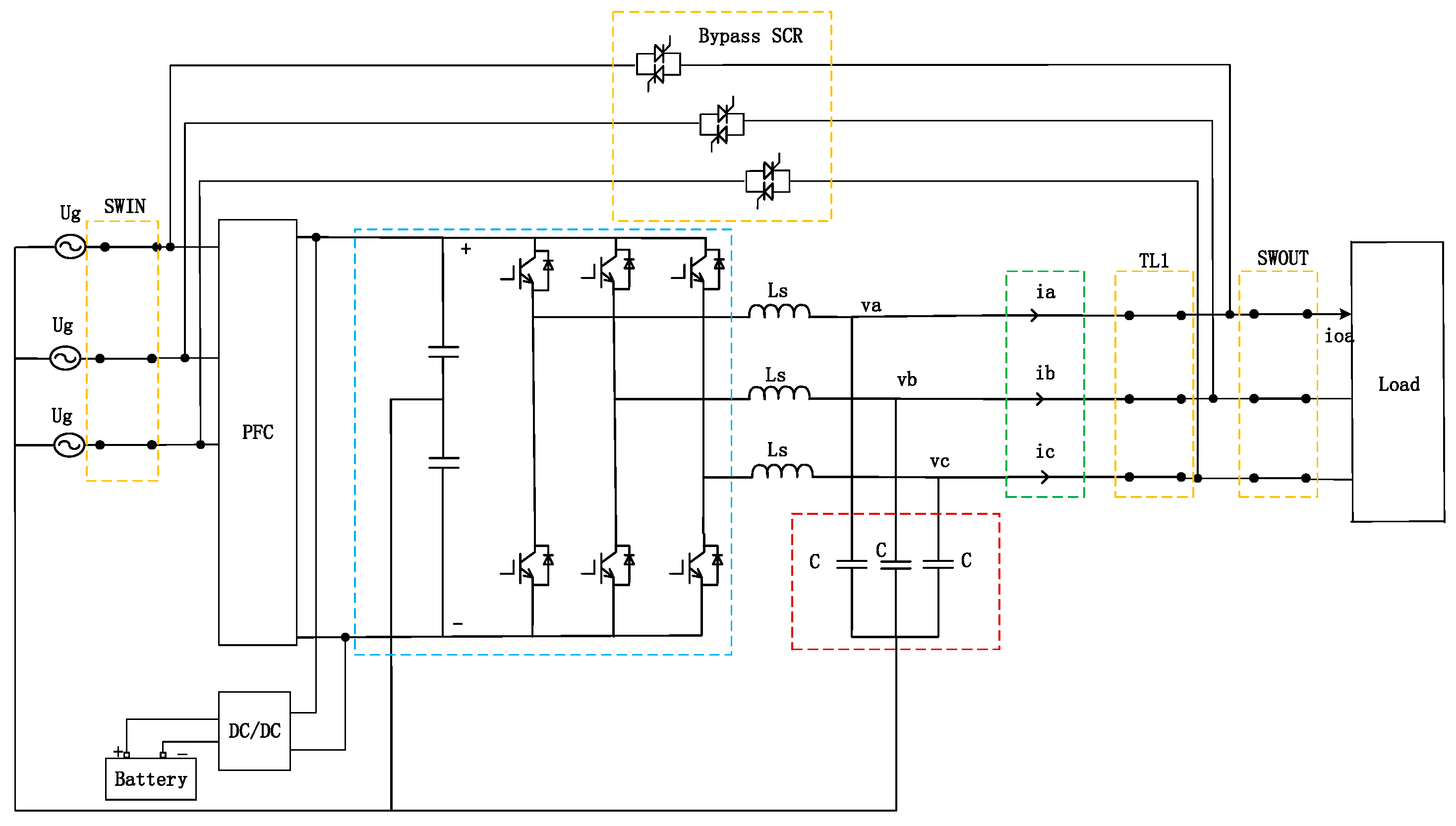
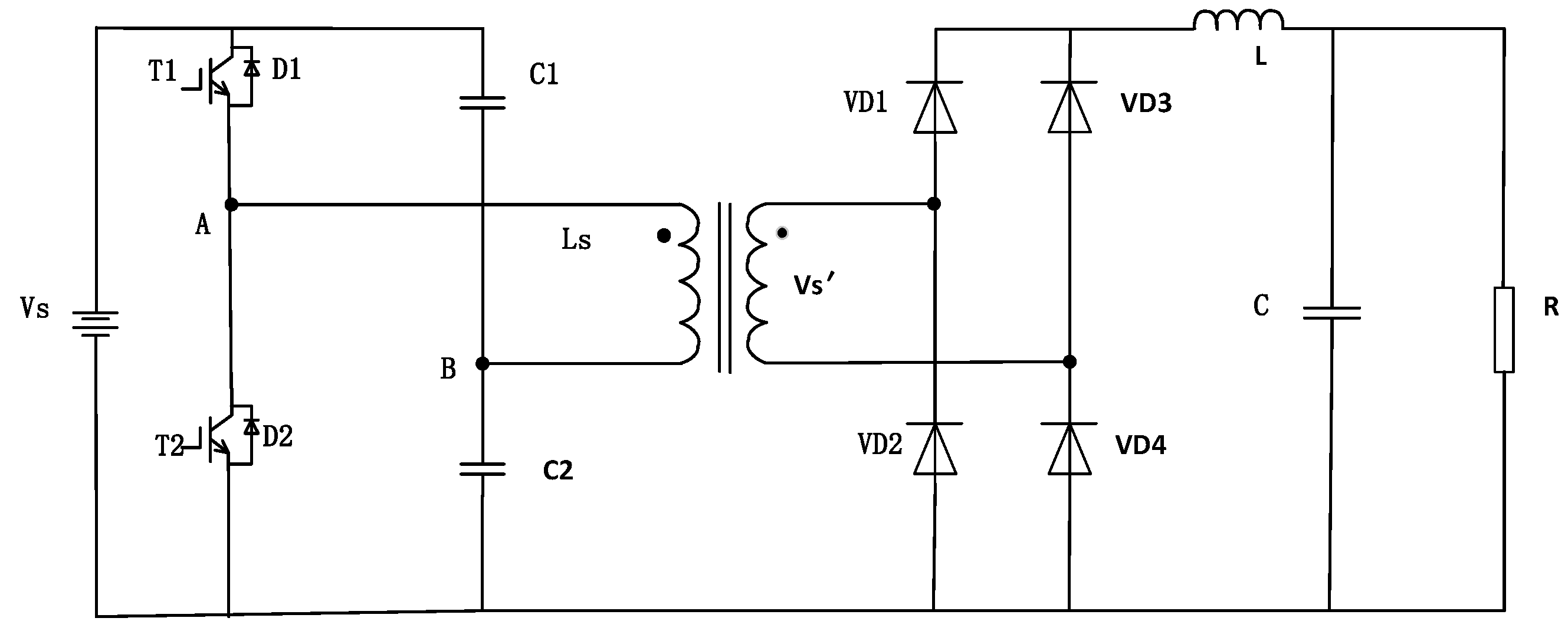
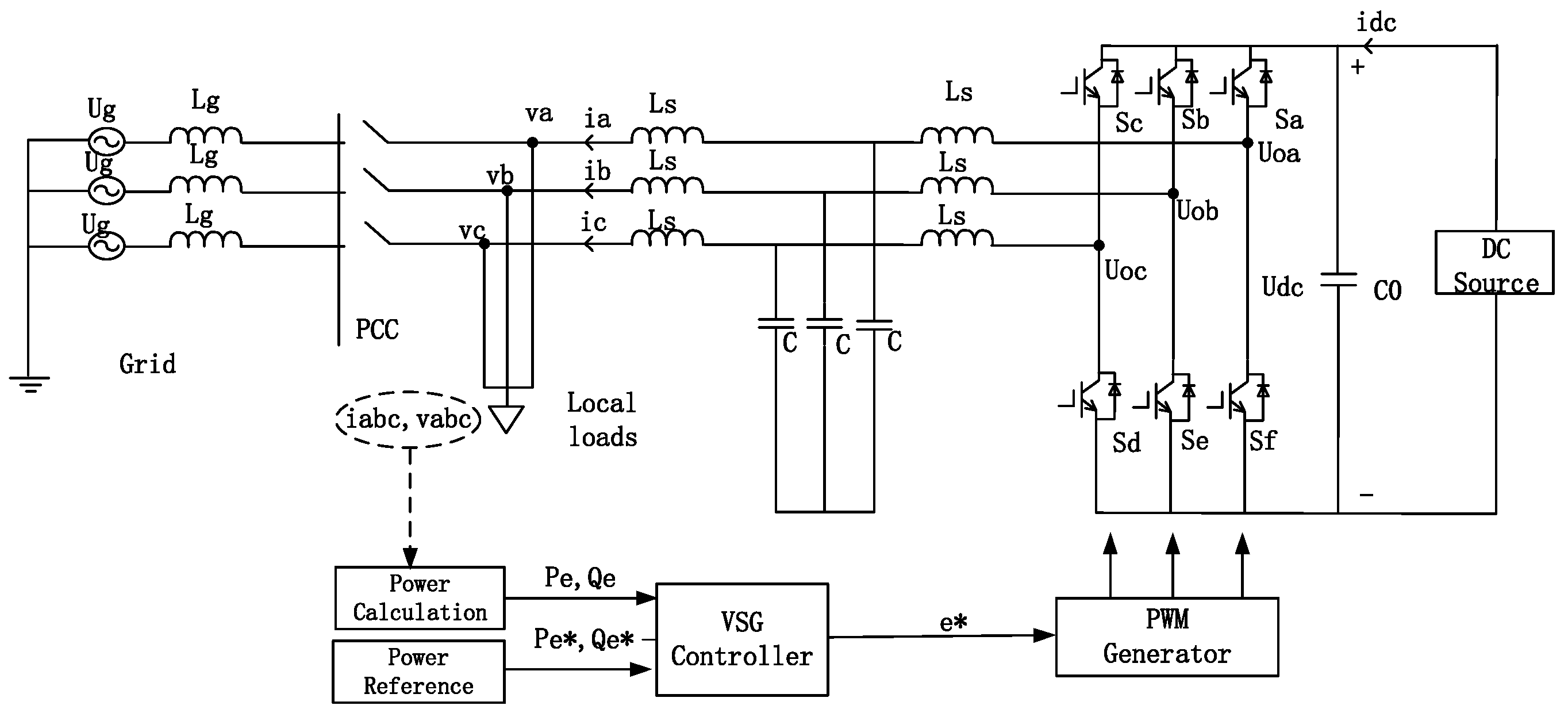
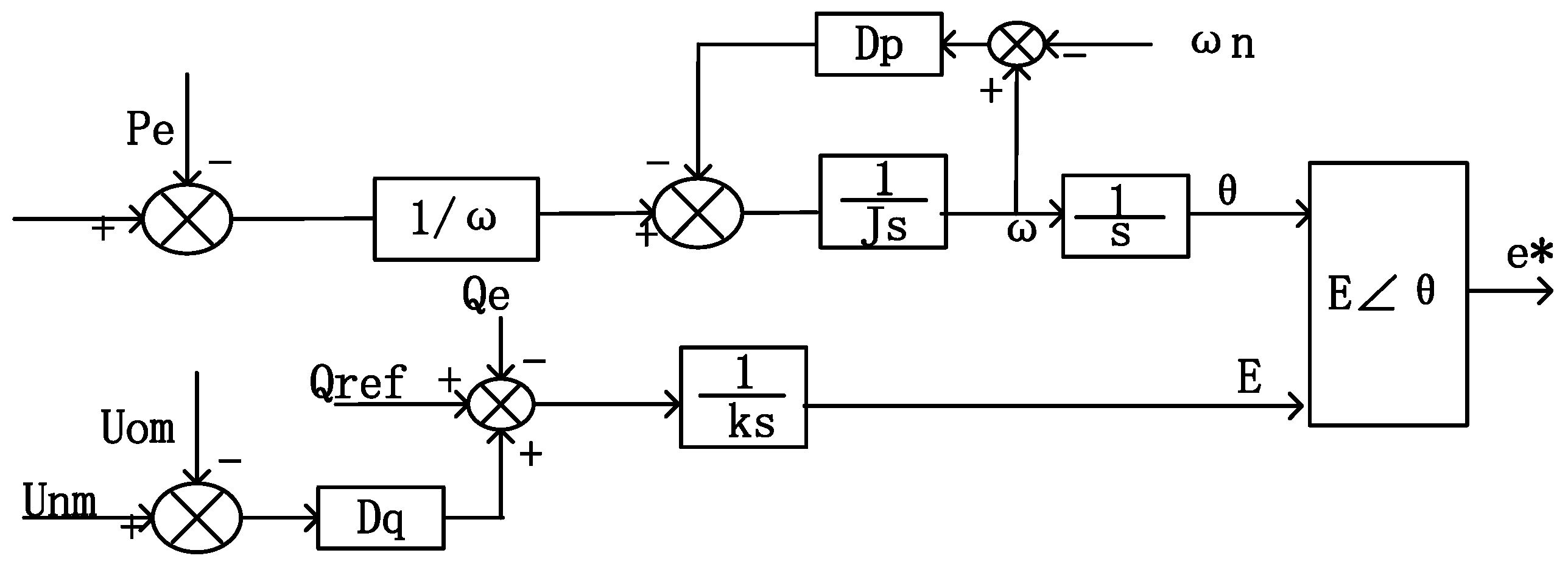
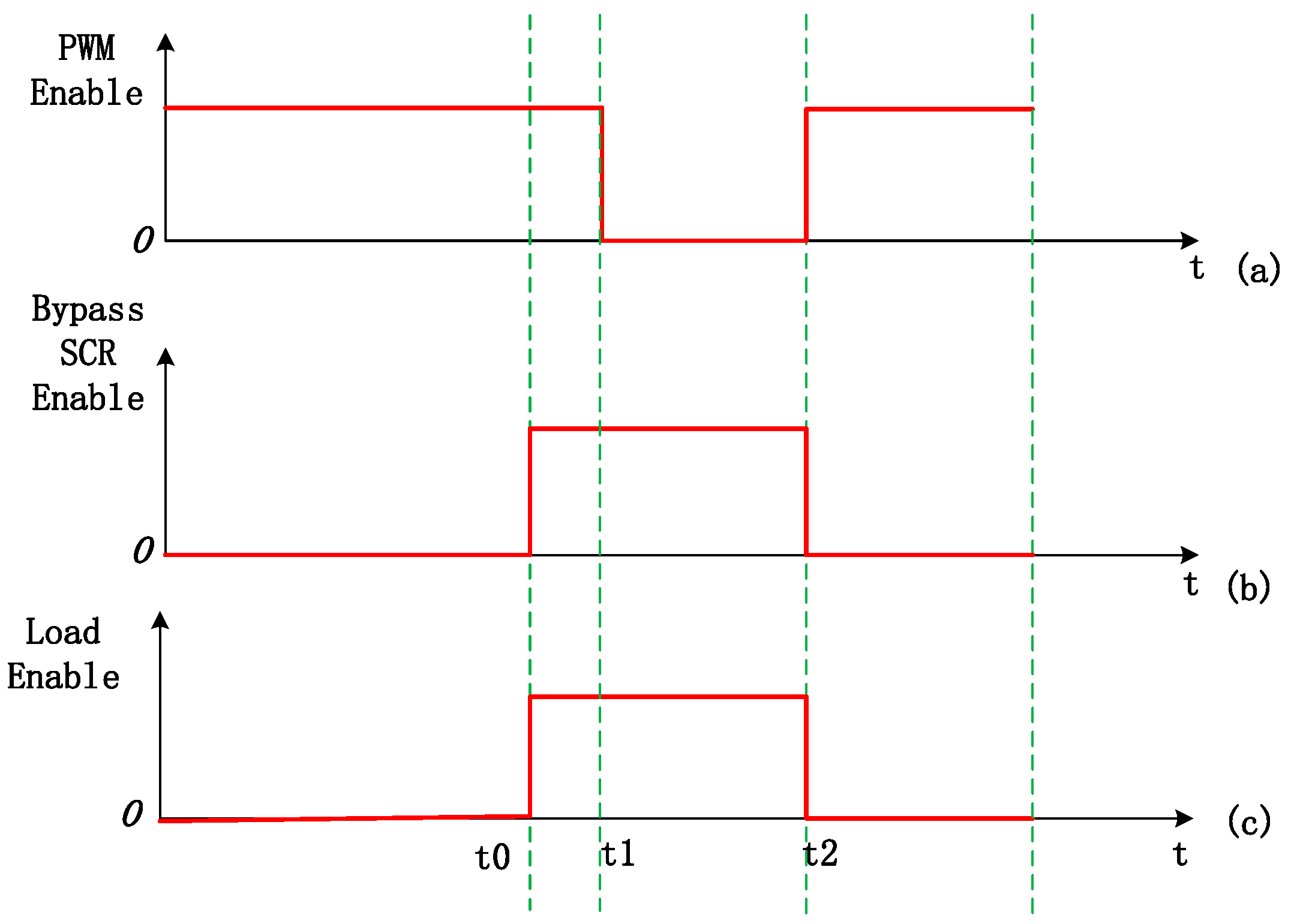
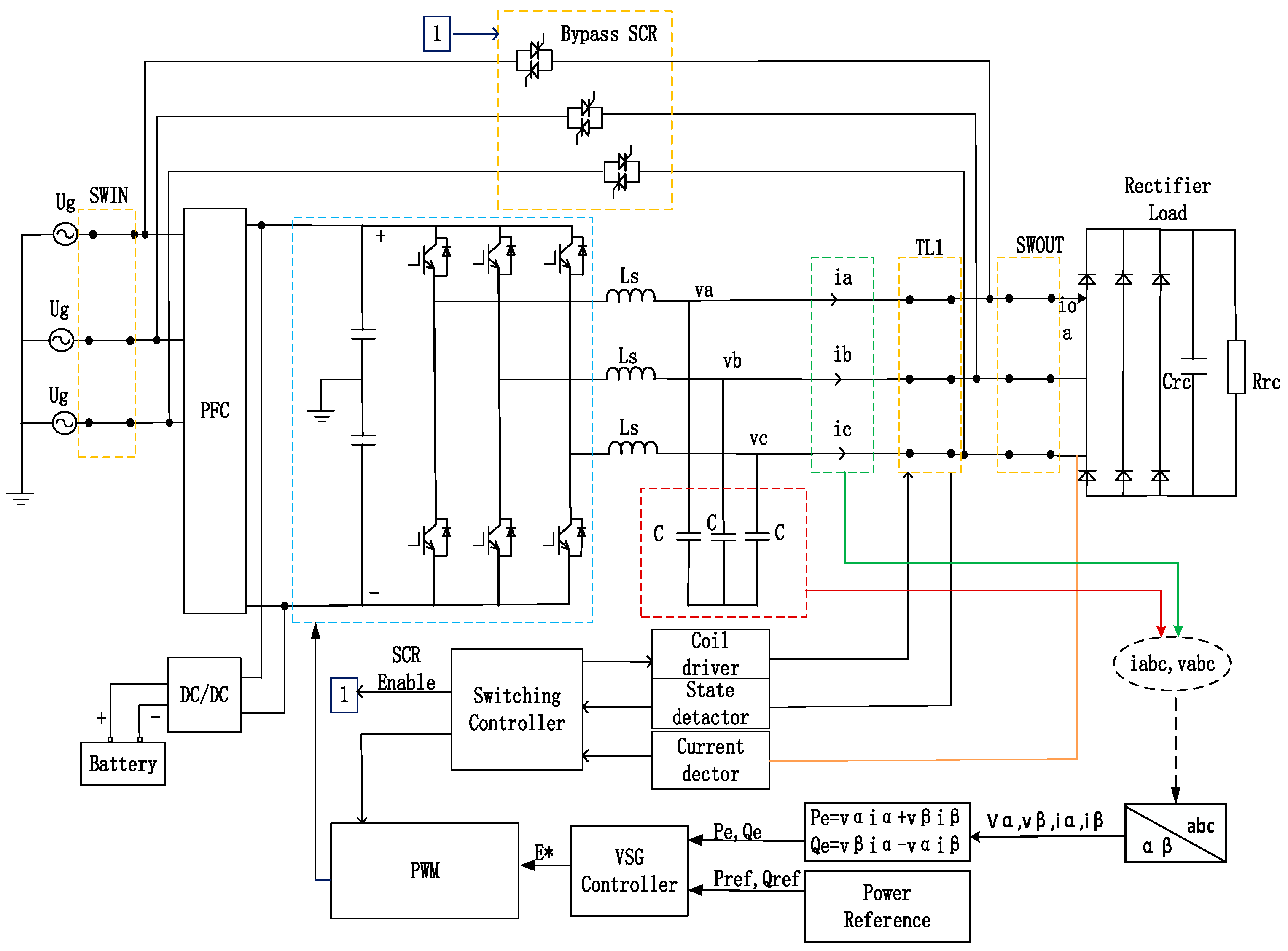
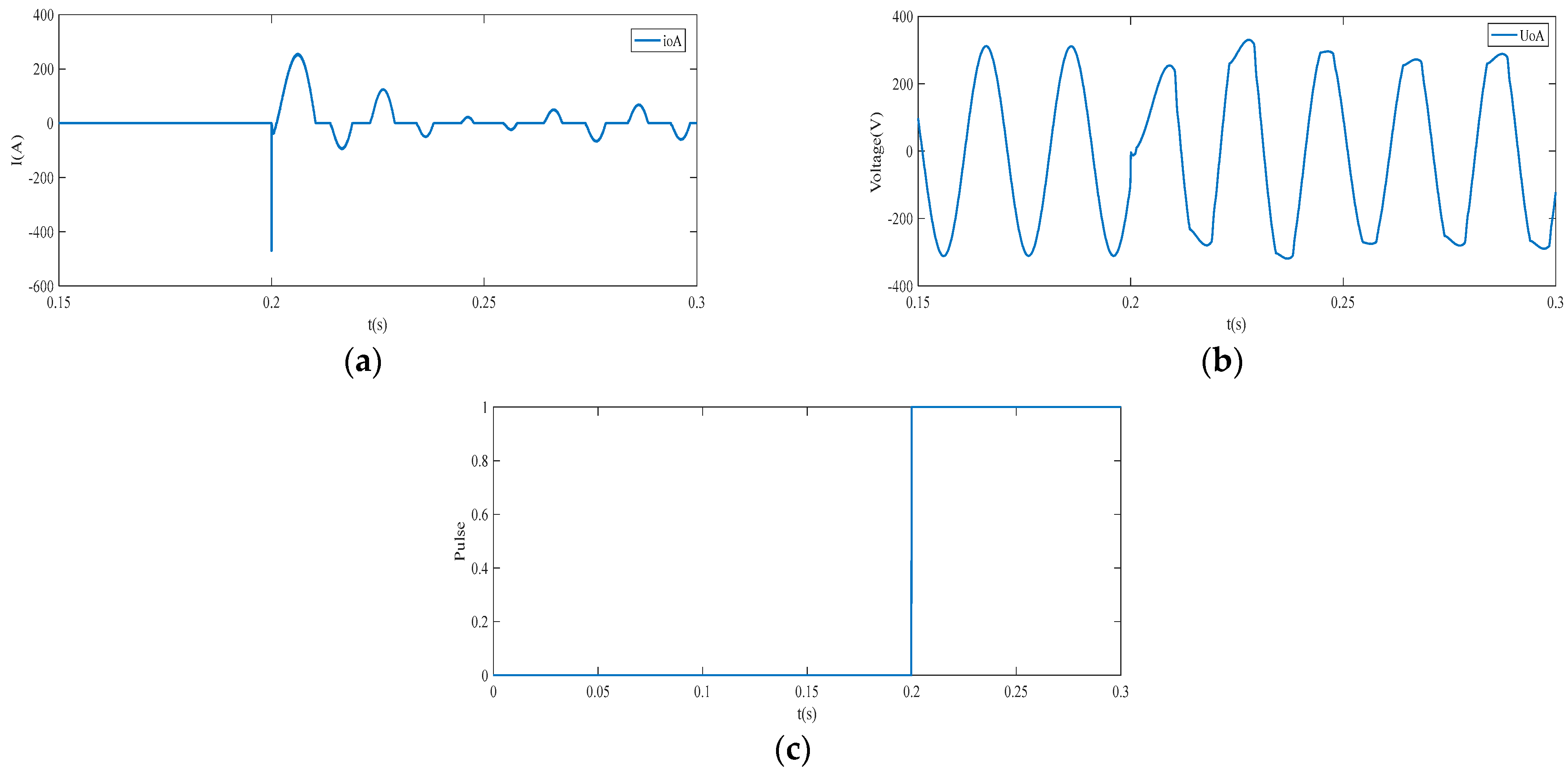
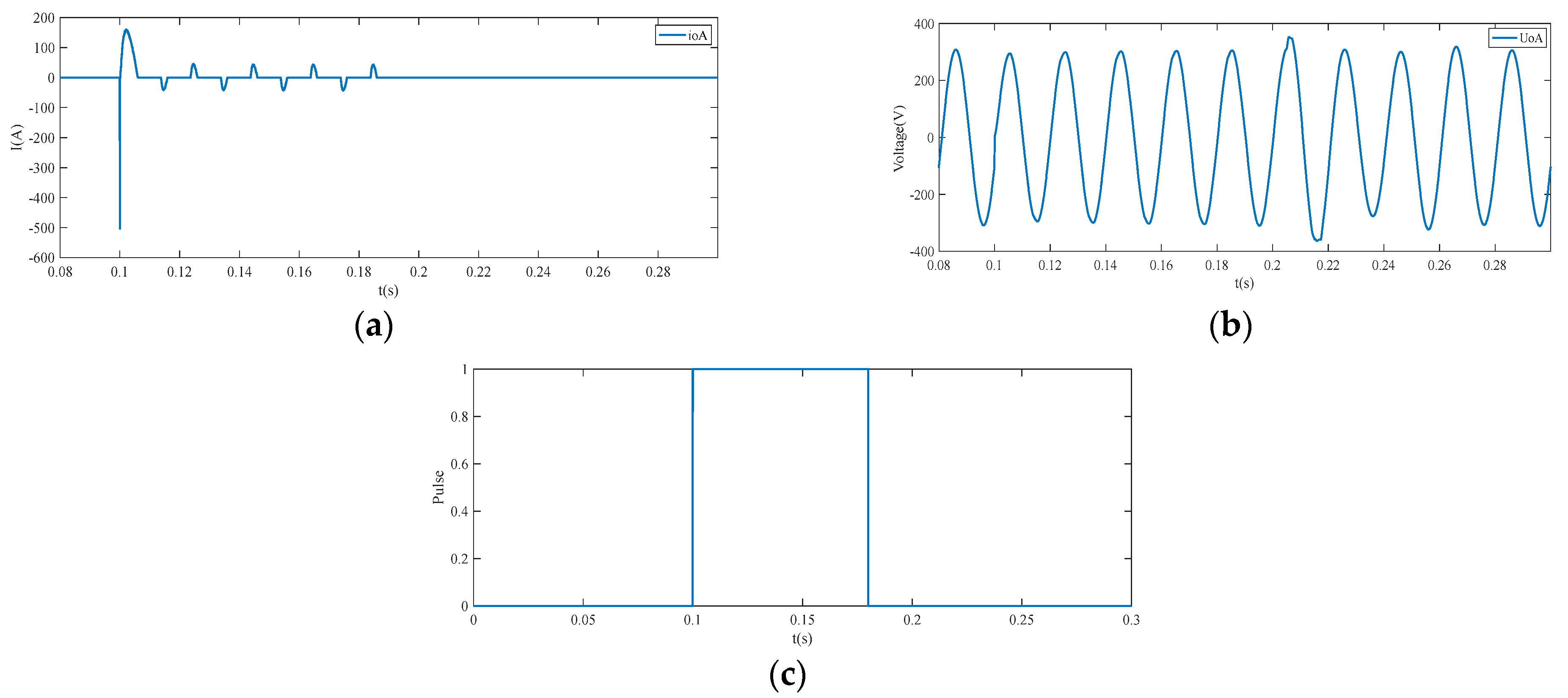

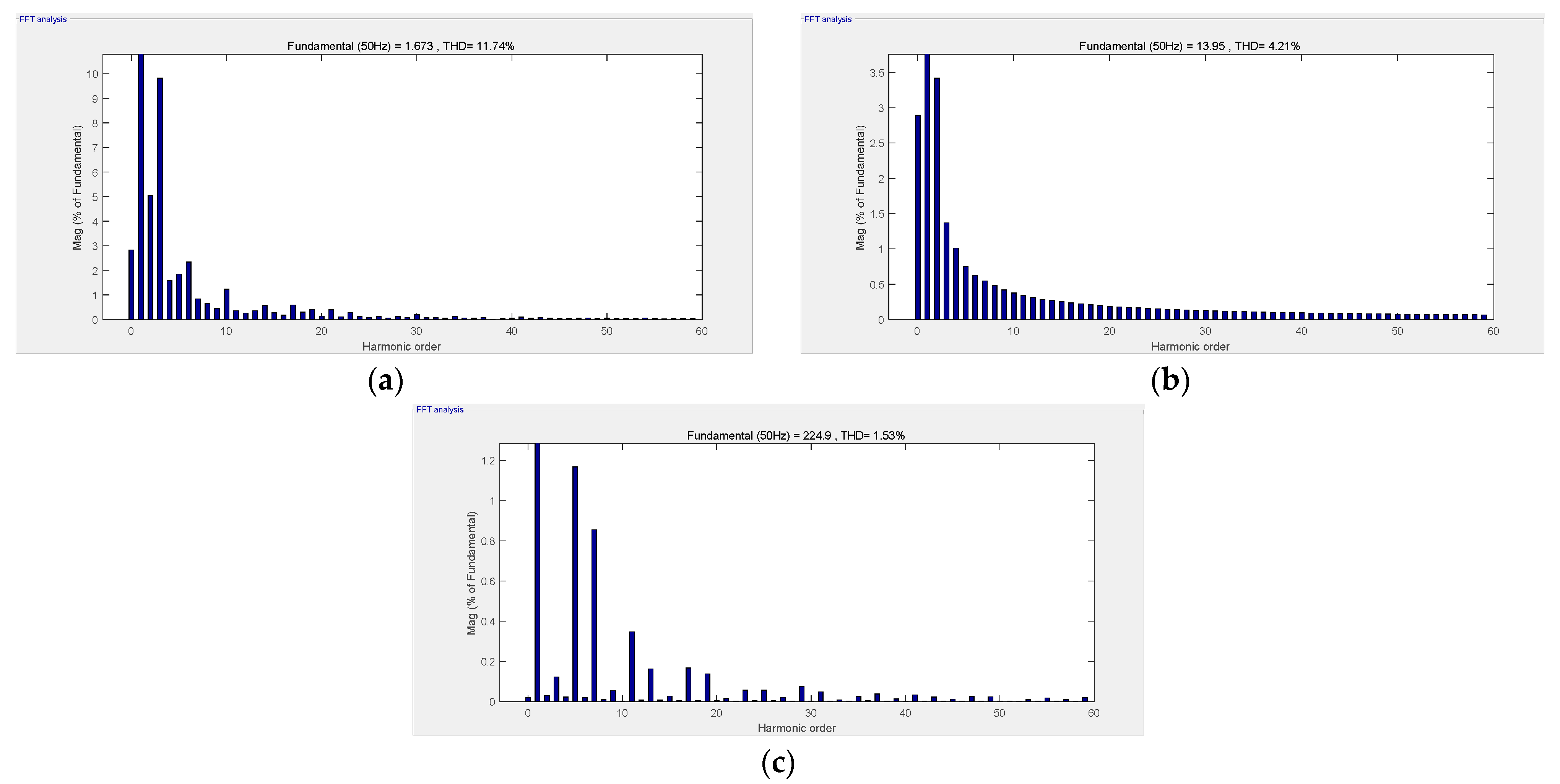






| Parameter Name | Parameter Value |
|---|---|
| rated voltage | 220 V |
| rated frequency | 50 Hz |
| filter capacitor | F |
| inverter side inductance | H |
| switching frequency | 10 kHz |
| load side inductance | H |
| Parameter Name | Parameter Value |
|---|---|
| 5.1 | |
| 322 | |
| J | 0.04 |
| K | 0.001 |
Publisher’s Note: MDPI stays neutral with regard to jurisdictional claims in published maps and institutional affiliations. |
© 2022 by the authors. Licensee MDPI, Basel, Switzerland. This article is an open access article distributed under the terms and conditions of the Creative Commons Attribution (CC BY) license (https://creativecommons.org/licenses/by/4.0/).
Share and Cite
He, G.; Zhao, L.; Dong, Y.; Li, G.; Zhang, W. A Novel VSG Control Strategy for UPS Voltage Source Inverter with Impulsive Load. Energies 2022, 15, 4702. https://doi.org/10.3390/en15134702
He G, Zhao L, Dong Y, Li G, Zhang W. A Novel VSG Control Strategy for UPS Voltage Source Inverter with Impulsive Load. Energies. 2022; 15(13):4702. https://doi.org/10.3390/en15134702
Chicago/Turabian StyleHe, Guofeng, Le Zhao, Yanfei Dong, Guojiao Li, and Wenjie Zhang. 2022. "A Novel VSG Control Strategy for UPS Voltage Source Inverter with Impulsive Load" Energies 15, no. 13: 4702. https://doi.org/10.3390/en15134702
APA StyleHe, G., Zhao, L., Dong, Y., Li, G., & Zhang, W. (2022). A Novel VSG Control Strategy for UPS Voltage Source Inverter with Impulsive Load. Energies, 15(13), 4702. https://doi.org/10.3390/en15134702





